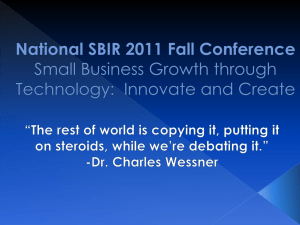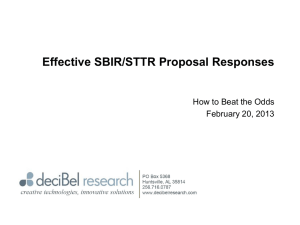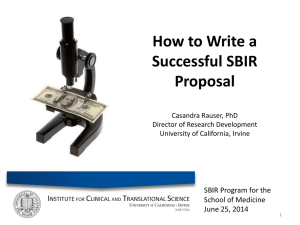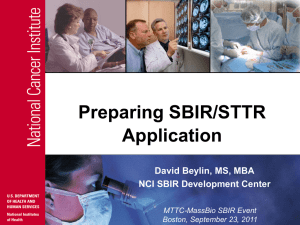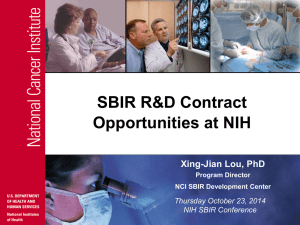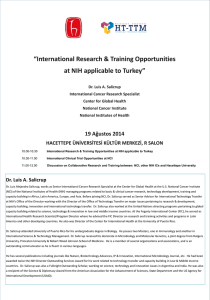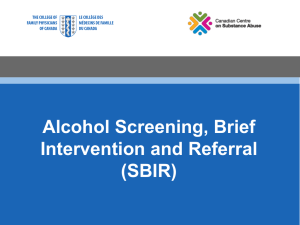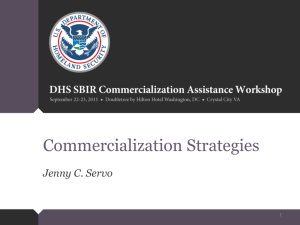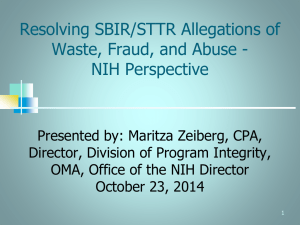AAPM SBIR & STTR
advertisement
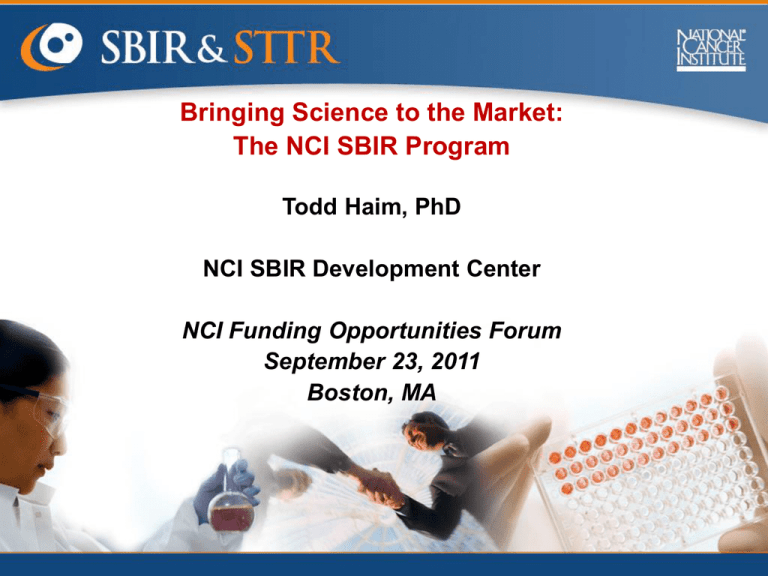
Bringing Science to the Market: The NCI SBIR Program Todd Haim, PhD NCI SBIR Development Center NCI Funding Opportunities Forum September 23, 2011 Boston, MA Today’s Presentation • Overview & Eligibility • NCI SBIR Development Center • NCI SBIR Initiatives: • SBIR Phase II Bridge Award • NCI Investor Forum • Regulatory Assistance Program • NIH SBIR/STTR Funding Opportunities 2 Congressional Goals 1. Stimulate technological innovation 2. Use small business to meet Federal R&D needs 3. Increase private-sector commercialization innovations derived from Federal R&D 4. Foster participation by minority and disadvantaged persons in technological innovation Small Business Innovation Development Act of 1982 Small Business Technology Transfer Act of 1992 3 Percent of NIH Budget Set Aside SBIR: Set-aside program for small business concerns to engage in Federal R&D with the potential for commercialization 2.5% STTR: Set-aside program to facilitate cooperative R&D between small business concerns and U.S. research institutions with potential for commercialization 0.3% ~$110 million annually at the NCI ~$650 million annually at the NIH 4 Reasons to Seek SBIR/STTR Funding • Provides seed funding for innovative technology development • Provides recognition, verification and visibility • Helps provide leverage in attracting additional funding or support (e.g., venture capital, strategic partner) Not a Loan No repayment is required Doesn’t impact stock or shares in any way (i.e. non-dilutive) • Intellectual property rights retained by the small business • Bayh-Dole Act (1980) 5 Three-Phase Programs PHASE I – R41, R43 • Feasibility Study • $150K and 6-month (SBIR) * • or 12-month (STTR) Award PHASE II – R42, R44 • Full Research/R&D • $1M and 2-year Award (SBIR & STTR) * • Commercialization plan required PHASE III • Commercialization Stage • Use of non-SBIR/STTR Funds * Note: Actual funding levels may differ by topic. 6 SBIR Eligibility Applicant must be a Small Business Concern (SBC) Organized for-profit U.S. business 500 or fewer employees, including affiliates PD/PI’s primary employment (i.e., >50%) must be with SBC at the time of award and for duration of the project period At least 51% U.S.- owned by individuals and independently operated OR At least 51% owned and controlled by another (one) business concern that is at least 51% owned and controlled by one or more individuals 7 STTR Eligibility Applicant is a Small Business Concern Formal Cooperative R&D Effort • 40% by small business • 30% by U.S. research institution U.S. Research Institution: College or University; Non-profit research organization; Federally-Funded R&D Center (FFRDC) Intellectual Property Agreement • Allocation SBC of IP rights (to SBC) and rights to carry out follow-on R&D and commercialization Principal Investigator’s primary employment may be with either the Small Business Concern or the research institution 8 SBIR/STTR Funding Distribution 2010 Budget SBIR STTR SBIR+STTR NIH $616M $74M $690M NCI $99M $12M $111M ← The annual SBIR/STTR budget for each participating Institute or Center (IC) is proportional to the total annual budget appropriation for that IC NIGMS NIDDK 9 SBIR Development Center Old SBIR Management Model at NCI • Awards were managed by 40-50 people who managed a combination of NIH grant mechanisms • The majority of these NCI program officers managed predominantly academic mechanisms and thus had an academic focus New Development Center at NCI • Team of 9 Program Managers/Directors, and one Center Director, entirely funded by NCI • Exclusively focused on the management of NCI’s SBIR/STTR portfolio • Directors have previous industry experience and professional networks to help mentor awardees in commercialization strategy and process • Center is developing a range of new activities to help small businesses • Center staff continues interactions with NCI program staff concerning cancer research 10 NCI SBIR Development Center Michael Weingarten, MA (Director) Ali Andalibi, PhD (Team Leader) Previous • NASA – Program Manager, NASA Technology Commercialization Program Previous • NSF – SBIR Program Director, Medical Biotechnology • House Ear Institute – Scientist & Director, New Technology and Project Development • Trega Biosciences, Inc. – Research Scientist Greg Evans, PhD (Team Leader) Previous • NHLBI/NIH – Program Director, Translational and Multicenter Clinical Research in Hemoglobinopathies • NHGRI/NIH – Senior Staff Fellow Jian Lou, PhD (Program Director) Previous • Johnson & Johnson – Research Scientist, Target Validation & Biomarker Development • Lumicyte, Inc. – Director, Molecular Biology Systems Analysis David Beylin, MS (Program Director) Previous • X/Seed Capital Management, LLC, Consultant • Naviscan PET Systems, Inc., Vice President, Research Andrew J. Kurtz, PhD (Program Director) Previous • NIH – AAAS Science & Technology Policy Fellow • Cedra Corporation – Research Associate, BioAnalytical Assay Development Patricia Weber, DrPH (Program Director) Previous International Heart Institute of Montana – Manager, Tissue Engineering and Surgical Research Ribi ImmunoChem Research, Inc. – Team Leader, Cardiovascular Pharmacology & Licensing Trega Biosciences - Director, Microbiology & Immunology Todd Haim, PhD (Program Manager) Previous • National Academy of Sciences – Christine Mirzayan Science and Technology Policy Fellow • Pfizer Research Laboratories – Postdoc Fellow, • Cardiac Pathogenesis & Metabolic Disorders Deepa Narayanan, MS (Program Director) Previous • Naviscan PET Systems, Inc., Director, Clinical Data Management (Oncology Imaging & Clinical Trials) • Fox Chase Cancer Center, Scientific Associate (Molecular Imaging Lab) Julienne Willis (Program Specialist) 11 Mentoring and Facilitation Goal • To work closely with promising SBIR Phase II awardees in order for them to advance their technologies towards the clinic Path • Active management of projects and better oversight • Mentor and guide companies throughout the award period • Provide Phase II awardees access to regulatory consultants to accelerate the FDA approval process for drugs, biologics and devices • When appropriate, act as a liaison to bring investors and NCI SBIR companies together SBIR & STTR: Three-Phase Program PHASE I – R41, R43 • Feasibility Study • $100K and 6-month (SBIR) * • or 12-month (STTR) Award PHASE II – R42, R44 • Full Research/R&D • $750K and 2-year Award (SBIR & STTR) * • Commercialization plan required Phase II Bridge Award PHASE III • Commercialization Stage • Use of non-SBIR/STTR Funds * Note: Actual funding levels may differ by topic. 13 NIH SBIR Program Current Challenge • Many awardees successfully complete Phase II without advancing far enough to attract private investment • Especially problematic for products requiring FDA approval • EXAMPLE: Preclinical drug development costs • $1-3 million (small molecules); $1-6 million (biologics) • Creates a significant funding gap: The “Valley of Death” • Investors have become increasingly risk averse & selective • Situation has been exacerbated by the economic downturn NCI Pilot Program Launched in 2008 • SBIR Phase II Bridge Award 14 EXAMPLE: Drug Development Target Identification & Validation Preclinical Development (Lead Development, Animal Studies, File IND) Phase I & Phase II SBIR Safety Review (IND) SBIR Bridge Award Clinical Trials NDA Review Commercialization Private Investment / Strategic Partner SBIR Bridge Award allows NIH to share investment risk by incentivizing Private Investors to evaluate projects and commit funds much earlier 15 Program Launched May 14, 2008 Program is Focused on Cancer Therapies, Imaging Technologies and Diagnostics • These areas require large amounts of capital for clinical validation and FDA approvals • Opportunity to impact approximately 75% of the projects in NCI’s current SBIR portfolio Budget & Eligibility • Provides up to $1 M per year for up to 3 years • Available to current Phase II awards & and those ending within last 2 years • Cancer-related Phase II projects funded by other NIH institutes and centers may be continued under the Bridge program 17 10 New Bridge Awards FY2009 + FY2010 Investor Total (3 yrs) $3.0M$62,950,000 for the commercialization of ASONEP™, a firstSan Diego, CA (3 yrs) NCI Total Leverage in-class monoclonal antibody against the angiogenic $27,395,816 growth factor S1P Oriental, NC $3.0M for theto development of a photoacoustic >2.3 1 computed tomography (CT) scanner for preclinical molecular imaging Norcross, GA $2.5M for the development of LightTouch®, a point-ofcare device for cervical cancer screening Northridge, CA $3.0M for the development of a novel molecular breast imaging technique to guide early-stage patient care Miramar, FL $3.0M for the development of ALT-801, a fusion protein consisting of IL-2 coupled with a soluble T-cell receptor fragment that recognizes a specific form of processed p53 antigen West Henrietta, NY $3.0M for the development of a cone beam breast CT scanner 18 2010 NCI SBIR Investor Forum hosted by San Jose BioCenter "The Forum was a great opportunity to get exposed to new companies in oncology." Ankit Mahadevia, M.D., MBA, Life Sciences Associate, Atlas Venture "I was very impressed with your choice of companies.The mix of stages was ideal." Sarah Bodary, Ph.D., Venture Partner, SV Life Sciences 19 Regulatory Assistance Program Highlights • New program launched January 2011 • Designed to assist companies working on therapeutics, devices, diagnostics, and other technologies requiring regulatory approval • Program will be available for up to 40 Phase II awardees per year • Provides up to 30 hours of consulting time to assist companies in developing a regulatory approval strategy and plan 20 Multiple Funding Solicitations NIH SBIR/STTR Omnibus Solicitations for Grant Applications Release: January Receipt Dates: April 5, August 5, and December 5 Solicitation of the NIH & CDC for SBIR Contract Proposals Release: August Receipt Date: Early November See NIH Guide for various other Program Announcements (PAs) and Requests for Application (RFAs), i.e. other grants Release: Weekly Receipt Dates: Various 21 Solicitation for SBIR Contracts Areas of interest to the commercial sector, based on market opportunity NCI scientific & technology priorities Contract topics in areas with strong potential for commercial success $25,020 NCI SBIR contracts (thousands) $16,665 $12,387 13% 2007 25% $7,757 17% % of total NCI SBIR 8% 2008 2009 2010 22 Differences between SBIR grants and contracts Omnibus Solicitation for SBIR Grants Solicitation for SBIR Contracts Scope of the proposal Investigator-defined (within mission of NIH) Defined by the NIH (focused topics) Questions during solicitation period? May speak with any Program Officer MUST contact the contracting officer Basis for Award Based on the score received during peer review If proposal scores well during peer review, must then negotiate a contract with NIH Reporting Final report (Phase I); Annual progress reports (Phase II) Monthly progress reports Phase II transition May apply as soon as Phase I aims are completed Must be invited by the NIH to submit Phase II proposal Set-aside of funds for particular areas? NO YES 23 NEW FY 2012 SBIR Contract Solicitation Funding Opportunity Summary PHS-2012-1 “Solicitation of NIH and CDC for SBIR Contract Proposals” ONE application receipt date per year: published in late August Next Receipt Date: November 7, 2011 RFP can be found at: http://grants.nih.gov/grants/funding/SBIRContract/PHS2012-1.pdf NCI published twelve topics (listed on the next slide) in the areas: Drugs Diagnostics Imaging Health IT Research tools NCI Contract Funding Topics 255 Development of Anticancer Agents (*) 277 Development of Companion Diagnostics (*) 291 Development of Radiation Modulators For Use During Radiotherapy 300 Reformulation of Cancer Therapeutics using Nanotechnology 301 Probing Tumor Microenvironment Using In-vivo Nanotechnology-based Sensors 306 Development of Innovative Algorithms for Processing & Analysis of In Vivo Images (*) 307 Novel Imaging Agents to Expand the Clinical Toolkit for Cancer Diagnosis, Staging, and Treatment 308 Automated Collection, Storage, Analysis, and Reporting Systems for Dietary Images 309 Development of Low Cost, Small Sample Multi-Analyte Technologies for Cancer Diagnosis, Prognosis and Early Detection 310 Simplified Tissue Microarray Instrument For Clinical and Research Settings (NIH Technology Transfer) 311 High Throughput Isolation of Antigen Specific T-cells for Cancer Therapy (NIH Technology Transfer) 312 Generation and Qualification of Site-specific Post-translationally Modified Proteins for Use as Calibrators in Pharmacodynamic (PD) Assays Example 1: Topic 291 Radiation Modulators Budget: Phase I $200,000 ; Phase II $1,500,000 Number of Anticipated Awards: 3-5 Project Goal: Development of radiosensitizers, radioprotectants, radiomitigators Phase I work scope may include: In vitro testing Clonogenic survival studies Preliminary toxicity, etc. Phase II work scope may include: In vivo experiments PK and PD in rodent model GMP drug production/sourcing, IND approval Example 2: Topic 307 Imaging Agents Budget: Phase I $250,000 ; Phase II $1,500,000 Number of Anticipated Awards: 3-5 Project Goal: Novel imaging agents for: early detection of cancer stratification of patients for selecting cancer therapy, surgical planning evaluation of tumor response to chemotherapy, radiation therapy, detection of cancer recurrence, etc. The work scope may include animal testing, formulation, GMP production, pharmacokinetic, pharmacodynamic, toxicological studies, etc. Example 3: Topic 277 Companion Diagnostics Budget: Phase I $200,000 ; Phase II $1,500,000 Number of Anticipated Awards: 4 Project Goal: Companion diagnostics for selecting patients for which a particular therapeutic regimen, including existing drugs and those in clinical development and radiation, will be safe and effective Phase I Work Scope: Test development and analytical validation If the drug is not commercially available – establish partnership w/ the source Phase II Work Scope: Full clinical validation RePorter – query tool Search Previous Awards RePorter http://projectreporter.nih.gov/reporter From September 1, 2009 the CRISP system (Computer Retrieval of Information on Scientific Projects) replaced by the RePORT Expenditures and Results query tool RePORTER RePORTER 24 hits 10 different ICs http://sbir.cancer.gov NCI SBIR Development Center Phone: 301-594-7709 E-mail: ncisbir@mail.nih.gov Register on web site for funding opportunity updates
